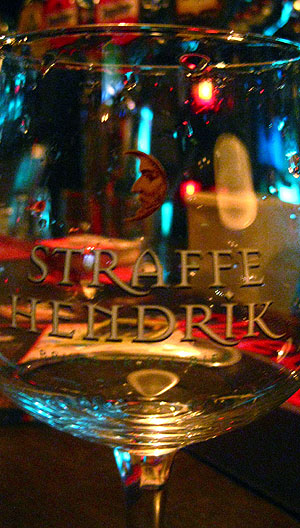Let me begin by telling you one thing: I am not a polar bear. I do not have layers of fur, nor do I find basking on a slowly-receding iceberg pleasurable. Now, you may think this rather obvious, dear reader, for you are of course reading words on a screen that could only have been typed by a bipedal human. If I were a polar bear, I would surely already be preaching the problems of climate change and bashing you for reducing my lounge space on a yearly basis.
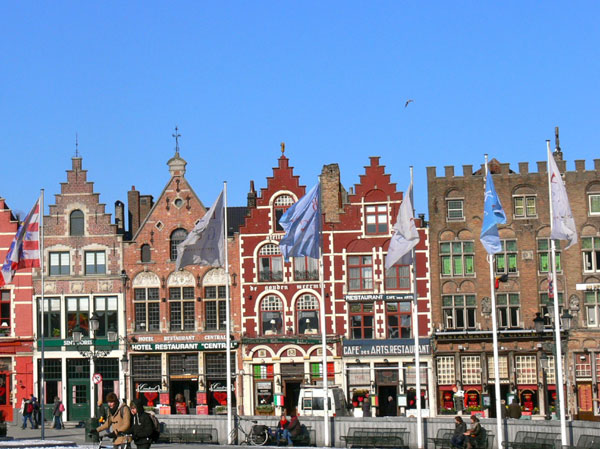
But here’s the problem: I am Canadian. This is not normally an issue. In fact, most people rather like us fair-weathered, friendly Canucks. But what you Brits seem to be convinced of is that my countrymen and I can acclimatise to the cold as much as those furry land-dwellers.
I cannot. It is a myth.
So, now you know: I am not immune to the cold, nor am I a fan of it. I may have been raised in a land where it is not uncommon to find yourself waddling down the street when it’s -30, but I never became accustomed to it. And, living in Britain for the past four and a half years has made me even more weak and wary of its bitter ways.
Thus, it was with an uncertain frame of mind that I arrived recently in Bruges (yes, I have seen the film – I know you’re going to ask). You see, Bruges is normally rather sheltered from the viciousness of winter weather that hits the majority of the continent. It is damp and chilly, but rarely sees snow. This, I was informed by one cab driver, is due to its proximity to the coast, which helps to moderate climes. But, as luck would have it, my friends and I turned up just after a deluge of snow and a settling in of frost with a penchant for biting.
After a morning relaxing on the Eurostar and a quick bit of shivering on the platform in Brussels waiting for our delayed train, we exited the compact, tinny Bruges station to the trickery of bright sunlight. “This won’t be so bad,” I thought. “It’s actually quite warm, like, in the sunshine, like,” proclaimed my jumpy Geordie friend.
It was not.
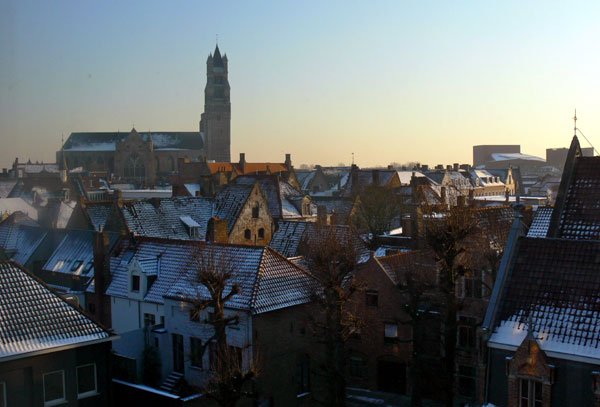
While waiting 15 minutes for a cab – partly due to the fact there weren’t any, and partly due to the fact young Brugians have no clue how a queue works – it slowly became apparent that, while it was sunny, it was in no way warm.
An action plan would have to be developed – there would be little room for canal visits, lazy meandering and window shopping. Instead, we would have to hop from indoor shelter to indoor shelter as quickly as our frozen feet could skid us.
Luckily, Bruges can pride itself not only on its fantastical spindly towers, picture-perfect squares and masterfully romantic bridge construction, but equally on its plethora of inviting chocolate shops, restaurants, art galleries, tea rooms, museums and pubs, all of which are enticingly warm. And while the historic centre of Bruges is less than two square miles around, it is amazing how little ground you desire to cover when the mercury spends its time hovering around the -8 degree mark.
In warmer weather, it would be the perfect city to get lost in. Almost no matter where you go, you can navigate by the belfry in the town’s central Markt (read: market) Square, stretching 83 metres into the skyline – a lovely landmark for the less map-savvy. At the end of March, the refurbished clock tower will reopen to the public and offer visitors far-reaching views of the town. Hemmed in on all sides by imposing cherry red and brown brick buildings topped with towers and oddly geometric roof edging, the Markt is a perfect place for meeting and people watching. If a snack is needed, you can try crunchy croquettes or frites with any number of sauces, from mayonnaise to curry, to something called “cocktail” which is apparently concocted from mayonnaise, ketchup and whisky. If you think this is just cheap street food, you’d be surprised: the two carts below the clock tower take their business seriously. And they should: according to one cart owner, the yearly rental is an astounding €100,000 per annum. Or maybe he just bloated this figure so we’d buy more chips. Surrounding the palatial plaza are dozens of cobbled, curving streets linking to the canal. In times when the swans are not huddling frozen on the ice, one could imagine a dreamy trip along it by boat.
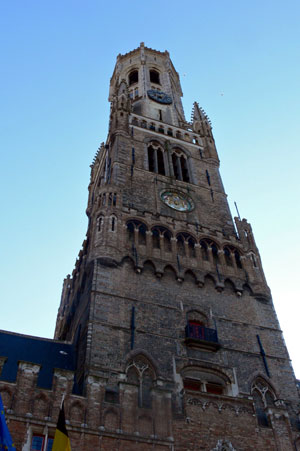 However, given getting lost would have likely led to death by exposure, the next best option was to head straight for a pub. After all, that is one of the other great things about Bruges: its beer. There are hundreds of beers made in Belgium and Bruges is happy to host them all in dozens of watering holes.
However, given getting lost would have likely led to death by exposure, the next best option was to head straight for a pub. After all, that is one of the other great things about Bruges: its beer. There are hundreds of beers made in Belgium and Bruges is happy to host them all in dozens of watering holes.
First though, you have to get used to the serving sizes: 330ml. After that, it’s the prices: normally €3.50 upwards for what is, essentially, a half pint. And finally, there’s the strength: usually above 8% ABV. Drinking copious amounts may be good for body warmth, but not for stability.
But it is good. Better than good. In fact, I can almost guarantee you will see your local’s host of light lagers in a whole other light when you return from a place like Bruges. It simply cannot compare.
Over the next four days, we would manage to hop from pub to pub, and even take in the rather impressive Bruges Beer Festival, which just happened to be going on while we were there. If you end up in Bruges in February 2013 I highly recommend visiting, given it offers more than 250 beers to try. For visits outside of the bustling beer festival season, there are places like the ‘t Brugs Beertje, on Kemelstraat. It’s a bit touristy but it offers hundreds of beers in a big book, so it’s a great place to start. Just off of Breidelstraat near the Markt, down a thin alleyway and up some higgledy piggledy winding stairs there lays De Garre. Try their house beer; it’s rich, wheaty and refreshing despite being 11%. Closer to our abode was De Kuppe on Kuipersstraat, which had a continual host of intriguing characters until the early hours.
And when you get bored of beer then head off to any of the myriad of Michelin star restaurants in the city. Bruges has more Michelin stars per capita than the rest of Belgium and a fair load of star-worthy restaurants besides. Try three star De Karmeliet on Langestraat or the tiny, seven-seater Aneth on Maria Van Bourgondiëlaan, just outside of the historic town centre.
If, however, you haven’t booked ahead at a top-line restaurant, a wander around the city provides many off the tourist path haunts that serve up tantalising meals. We stumbled upon Trattoria Trium, a little Italian joint on Academiestraat. Worried it would be just an over-priced pasta place, we shuffled in from the chill on-guard. Within seconds, we were welcomed with open arms and the scent of gooey pizza overwhelmed our frozen nostrils. In the daytime, the trattoria also acts as a deli, so the meat on the pizzas and in the antipasti is proper: cured salami, mortadella and prosciutto are heaped onto a platter with olives for €13. At the next-door table, a chap from Norwich struck up a conversation with us, his Belgian friends soon joining in, in perfect English. “You have chosen the best Italian place in all of Belgium,” said one, kissing her fingers and joining them in the “perfect” symbol. They insisted we try the creamy, finger-licking tiramisu and even paid for our portion for six people on their way out. Warm, friendly: a cosy joint, indeed.
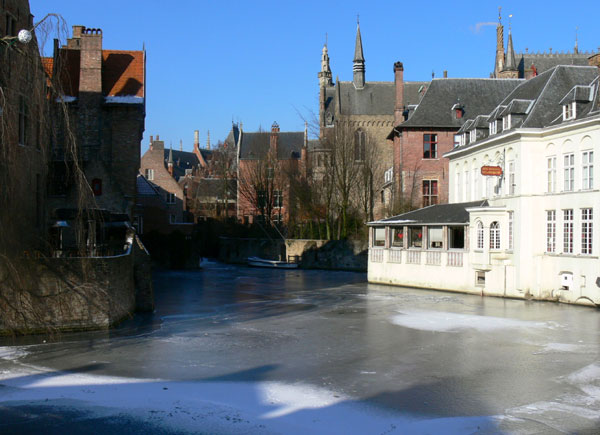
Once the beer and food has you satiated, Bruges also offers up some top-end museums and art galleries. Try the Salvador Dali museum by the belfry or take a look at inspiring local art at the Absolute Art Gallery on Dijver street by the canal. The Groeninge Museum, also on Dijver, offers a selection of paintings by Flemish artists from the 14th to 20th century. There is also the Museum of Chocolate on Wijnakstraat and its sister space on Vlamingstraat, the Frites Museum. Now, laugh if you will, but I would assume that you probably know very little about the humble potato, but by the time you leave that two storey museum featuring boards on its history, use, legend, proliferation in Europe and eventual translation into the famous chip (or frite) you will find yourself using potato factoids at all the top parties for months to come. It’ll be Prada and potatoes for you.
And of course, there is the great outdoors. Bruges is a town filled with dreamy sights sure to engorge you with a relaxed and misty frame of mind. Cobbled alleys with shoebox houses turn pink and orange in the fading light; canals drift lazily through the town; and, courtyards lead onto fantastic mediaeval church grounds.
I just don’t recommend going when it’s too cold to feel your toes; unless you’re a polar bear.

